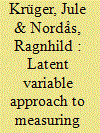| Srl | Item |
| 1 |
ID:
176042


|
|
|
|
|
| Summary/Abstract |
Conflict-related sexual violence is an international security problem and is sometimes used as a weapon of war. It is also a complex and hard-to-observe phenomenon, constituting perhaps one of the most hidden forms of wartime violence. Latent variable models (LVM) offer a promising avenue to account for differences in observed measures. Three annual human rights sources report on the sexual violence practices of armed conflict actors around the world since 1989 and were coded into ordinal indicators of conflict-year prevalence. Because information diverges significantly across these measures, we currently have a poor scientific understanding with regard to trends and patterns of the problem. In this article, we use an LVM approach to leverage information across multiple indicators of wartime sexual violence to estimate its true extent, to express uncertainty in the form of a credible interval, and to account for temporal trends in the underlying data. We argue that a dynamic LVM parametrization constitutes the best fit in this context. It outperforms a static latent variable model, as well as analysis of observed indicators. Based on our findings, we argue that an LVM approach currently constitutes the best practice for this line of inquiry and conclude with suggestions for future research.
|
|
|
|
|
|
|
|
|
|
|
|
|
|
|
|
| 2 |
ID:
186445


|
|
|
|
|
| Summary/Abstract |
Enhancing residential solar photovoltaic adoption greatly contributes to the energy sector's decarbonization. However, even though expanding the capacity will increase the amount of solar-derived energy, little is known about what drives households' capacity choice. To bridge this knowledge gap, the current study utilizes revealed data provided by a Japanese solar photovoltaic installer on households' capacity choices and conducts a survey of households that have installed solar photovoltaic systems through diverse installers. The descriptive evidence shows that the Japanese feed-in tariff implemented in 2012 drastically expanded capacity per installation. The revealed data also record house attributes, meteorological information, and municipality demographic variables, on which we regress the solar photovoltaic capacity. We found that capacity is determined by the marginal cost and marginal benefit of installing an additional capacity. The survey results suggest that installers play a critical role in determining capacity through recommendations, once they gain households' trust. Thus, policy interventions that incentivize installers to expand capacity can enhance the generation of solar-derived energy.
|
|
|
|
|
|
|
|
|
|
|
|
|
|
|
|